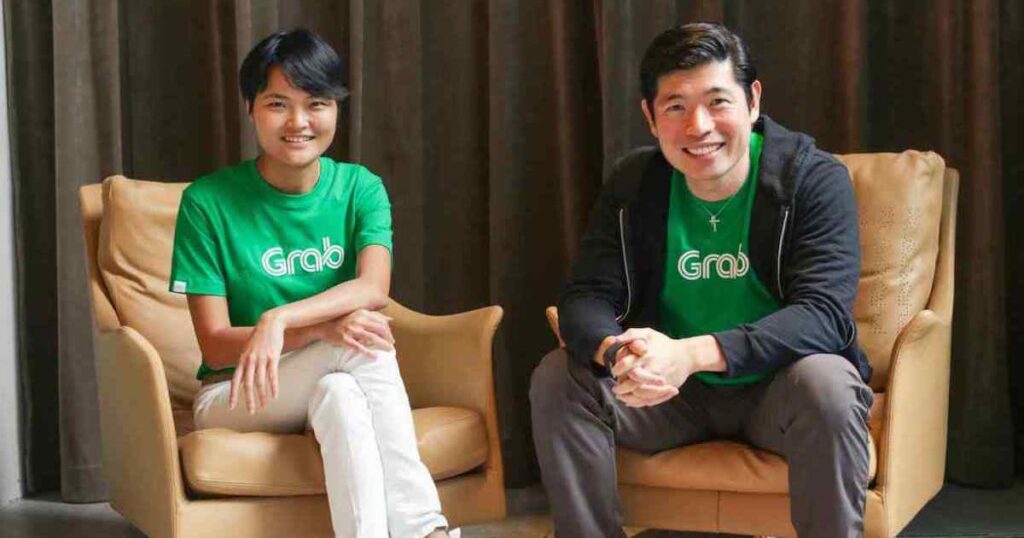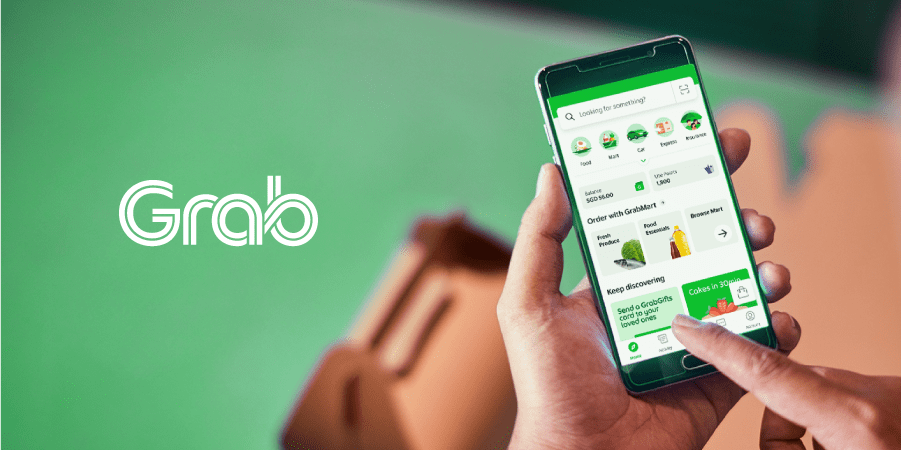Grab is a Southeast Asian superapp with a mission to drive Southeast Asia forward by offering everyday services that matter. It started out as a taxi-hailing app in 2012, and has since expanded its product offerings to include ride-hailing, food delivery, grocery and package delivery, and financial services. Grab is now Southeast Asia’s leading superapp, with over 190 million users across six countries.
Grab was founded by Anthony Tan and Tan Hooi Ling in 2012. Tan, who is the company’s CEO, is a graduate of Harvard Business School. Ling, who is Grab’s COO, is a graduate of the Wharton School of the University of Pennsylvania.
Grab has raised over $10 billion in funding from investors such as SoftBank Vision Fund, Temasek Holdings, and Microsoft. The company is headquartered in Singapore and has offices in over 30 cities across Southeast Asia.
In 2021, Grab went public through a merger with a special purpose acquisition company (SPAC). The merger valued Grab at $40 billion, making it the largest SPAC merger at the time.
Grab is a key player in the Southeast Asian economy. The company employs over 2 million people and contributes billions of dollars to the region’s GDP. Grab is also a major driver of innovation in Southeast Asia. The company has pioneered new technologies and business models that are transforming the way people live and work in the region.
Here are some of the key features of Grab:
- Ride-hailing: Grab offers a variety of ride-hailing options, including taxis, private cars, and motorbikes.
- Food delivery: GrabFood is a food delivery service that connects users with restaurants and food stalls across Southeast Asia.
- Grocery and package delivery: GrabExpress is a same-day delivery service that delivers groceries, packages, and other items to users within minutes.
- Financial services: Grab Financial Group offers a range of financial services, including payments, insurance, and micro-financing.
Grab is a leading provider of everyday services in Southeast Asia. The company is committed to driving Southeast Asia forward by providing convenient, reliable, and affordable services to its users.
Founding Story and History of Grab
Grab was founded in 2012 by Anthony Tan and Tan Hooi Ling, both graduates of Harvard Business School. The idea for Grab originated when Anthony Tan attended a conference in the United States and realized the potential for ride-hailing services in Southeast Asia. Inspired by Uber’s success, he saw an opportunity to bring a similar service to the region.

Anthony Tan, who comes from a prominent Malaysian family with a background in the automotive industry, teamed up with Tan Hooi Ling, his Harvard classmate, to launch what was initially known as MyTeksi. The name “MyTeksi” combined “my” (a possessive pronoun often used in Southeast Asian languages) and “teksi” (the Malay word for taxi).
The founders faced several challenges in the early stages, including convincing traditional taxi drivers to embrace their platform. They worked hard to build trust and develop relationships with taxi companies and drivers, emphasizing the benefits of using technology to streamline the process of matching drivers with passengers.
MyTeksi launched its first service in Malaysia in June 2012, allowing passengers to book taxis through a mobile app. The service quickly gained traction, and the founders saw the potential for expansion across Southeast Asia. They rebranded the company as GrabTaxi in 2013 to reflect its wider range of services beyond just taxis.
In 2014, GrabTaxi secured a significant funding round led by Tiger Global Management, which provided the company with the resources needed to expand its operations. GrabTaxi expanded into new markets, including Singapore, the Philippines, Thailand, Vietnam, and Indonesia, where it encountered competition from other ride-hailing platforms.
To further strengthen its position in the market, GrabTaxi embarked on strategic partnerships and acquisitions. In 2015, GrabTaxi acquired the Southeast Asian operations of Uber, making it the dominant ride-hailing platform in the region. This move allowed Grab to absorb Uber’s operations and driver-partners, solidifying its market position.
As Grab continued to diversify its services, it rebranded once again in 2016, dropping the “Taxi” from its name and becoming simply “Grab.” The new name reflected the company’s vision to provide a broader range of on-demand transportation services beyond taxis.
In subsequent years, Grab expanded its services beyond transportation. It introduced GrabCar, which allowed users to book private cars, and later launched GrabFood for food delivery, GrabExpress for courier services, and GrabPay for digital payments. Grab also ventured into financial services through GrabFinancial, offering services such as digital wallets, lending, and insurance.
Grab has continued to grow and innovate, securing significant funding from various investors and partnering with local governments and businesses to expand its reach and offer new services. Grab remains one of the leading technology companies in Southeast Asia, serving millions of users across multiple countries.
The Business Model of Grab: Revolutionizing Southeast Asia’s On-Demand Economy
Grab has emerged as a dominant force in the on-demand economy of Southeast Asia. Initially launched as a ride-hailing platform, Grab has expanded its services to include transportation, food delivery, financial services, and more. Let’s delve into the business model that has propelled Grab’s success, exploring its key components and strategies.
Transportation Services: At the core of Grab’s business model is its transportation services. Users can book various types of rides, including taxis, private cars (GrabCar), and motorbikes (GrabBike), through the Grab mobile app. Grab’s app leverages GPS technology to match passengers with available drivers, ensuring convenience and efficiency.
Grab employs two primary models for its transportation services:
a. Ride-hailing: Grab acts as an intermediary platform connecting passengers with drivers, charging a commission fee from drivers for each completed ride. This model enables Grab to scale rapidly without owning a fleet of vehicles.
b. Ride-sharing: Grab introduced GrabShare, a ride-sharing feature that allows multiple passengers heading in the same direction to share a ride, reducing costs and minimizing traffic congestion.
Food Delivery Services: Recognizing the growing demand for food delivery, Grab ventured into this sector with GrabFood. Users can order food from a wide range of restaurants through the Grab app, and Grab’s delivery partners fulfill the orders. Grab earns revenue through commissions charged to restaurants and delivery fees paid by customers.
Financial Services: Grab expanded beyond transportation and delivery, establishing GrabFinancial to provide a suite of financial services tailored to the needs of its user base. The key offerings include:
a. GrabPay: A digital wallet enabling users to make cashless transactions for Grab services and at partner merchants. Grab earns revenue through transaction fees and potential interest on stored wallet balances.
b. GrabInsurance: Partnering with insurers, Grab offers various insurance products, including motor insurance and personal accident coverage, providing users with convenient access to insurance solutions.
c. GrabFinance: Grab offers lending services to driver-partners and small businesses, providing them with access to capital for vehicle purchases, business expansion, or working capital. Interest and fees on loans generate revenue for Grab.
Partnerships and Collaborations: Grab actively seeks partnerships with governments, corporations, and other entities to expand its services and improve its offerings. These collaborations include:
a. Government collaborations: Grab collaborates with local governments to enhance transportation infrastructure, promote ride-sharing initiatives, and contribute to smart city development.
b. Corporate partnerships: Grab partners with various companies, such as hotels, airlines, and e-commerce platforms, to offer integrated services, loyalty programs, and joint promotions, driving customer engagement and retention.
c. Strategic acquisitions: Grab has strategically acquired competitors or expanded its operations by acquiring local players to consolidate its market position and gain access to new markets.
Data Analytics and Technology: Grab’s success is underpinned by advanced data analytics and technology-driven solutions. The company leverages data from user preferences, ride patterns, and delivery trends to optimize operations, personalize user experiences, and offer targeted promotions. Grab’s continuous investment in technology ensures a robust and user-friendly platform.
Grab’s business model demonstrates a comprehensive approach to meet the evolving demands of Southeast Asia’s on-demand economy. By diversifying its services, forging partnerships, and leveraging data-driven insights, Grab has created an ecosystem that addresses various customer needs. As Grab continues to innovate and expand, it aims to be Southeast Asia’s go-to platform for everyday services, transforming the way people move, eat, and transact in the region.
Revenue Streams of Grab: Unlocking Growth in Southeast Asia’s On-Demand Economy
Grab has built a diverse range of services that extend beyond ride-hailing to include food delivery, financial services, and more. This article delves into revenue streams that fuel Grab’s growth and sustainability. Understanding these revenue streams is key to comprehending Grab’s business model and its ability to capitalize on the on-demand economy.
Ride-hailing: Grab’s primary revenue stream is from its ride-hailing business. The company charges a commission on each ride that is completed through its platform. The commission rate varies depending on the type of ride and the market in which it is taken. For example, the commission rate for a taxi ride in Singapore is 15%, while the commission rate for a private car ride in Indonesia is 20%.
Food delivery: Grab also generates revenue from its food delivery business, GrabFood. The company charges a commission on each food delivery order that is placed through its platform. The commission rate varies depending on the restaurant and the market in which the order is placed. For example, the commission rate for a food delivery order from a restaurant in Singapore is 15%, while the commission rate for a food delivery order from a restaurant in Indonesia is 20%.
Grocery and package delivery: Grab also generates revenue from its grocery and package delivery business, GrabExpress. The company charges a delivery fee on each grocery or package delivery order that is placed through its platform. The delivery fee varies depending on the distance and the weight of the item being delivered. For example, the delivery fee for a grocery delivery order within 3 kilometers is $2, while the delivery fee for a package delivery order that weighs 10 kilograms is $5.
Financial services: Grab also generates revenue from its financial services business, Grab Financial Group. The company offers a range of financial services, including payments, insurance, and micro-financing. Grab charges fees for these services, which are a source of revenue for the company. For example, Grab charges a fee for each GrabPay transaction that is made.
In addition to these four revenue streams, Grab also generates revenue from advertising. The company sells advertising space on its platform to businesses that want to reach its users. The amount of revenue that Grab generates from advertising varies depending on the number of users that are using its platform and the type of advertising that is being sold.
Overall, Grab’s revenue streams are diversified and allow the company to generate revenue from a variety of sources. This helps to reduce the company’s risk and makes it more sustainable in the long term.
Also Read: The Rise and Challenges of Uber: A Story of Disruption
To read more content like this, subscribe to our newsletter
Go to the full page to view and submit the form.


